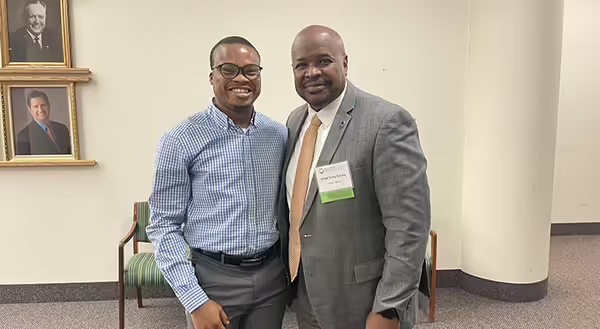
This blog was guest written by Kehinde Adesina, ISPP Scholar with the Illinois Department of Agriculture, Division of Natural Resources.
On January 25, 2024, I attended the 2024 Illinois Nutrient Loss Reduction Strategy (NLRS) Partnership Conference, a pivotal event held both at the Illinois Department of Agriculture in Springfield and online. Open to Policy Working Group members, stakeholders, and the general public, the conference highlighted the latest updates from the NLRS 2023 Biennial report, focusing on reducing nutrient loss in Illinois.
At the conference, I got hold of the executive summary of the comprehensive strategy that addresses nitrogen and phosphorus entering waterways, emphasizing collaboration between state and federal agencies, cities, non-profits, and technical experts.
Despite sector-wide investments, nutrient levels in Illinois waterways increased in 2021-22, challenging the strategy's 2025 interim goals. The agricultural sector faces barriers, necessitating swifter adoption of conservation practices. The long-term objective aims for a 45% reduction in total phosphorus and total nitrogen loads, recognizing the importance of additional investments in resources for effective implementation and outreach. The Illinois NLRS underscores its commitment to improving water quality and reducing the hypoxic zone in the Gulf of Mexico.
As a government policy enthusiast, my takeaway from this conference was the U.S. Department of Agriculture Natural Resources Conservation Service (USDA, NRCS) Chief Terry Cosby’s explanation of the impact of the Inflation Reduction Act Funding – the largest piece of federal legislation ever to address climate change, which will invest $783 billion in provisions relating to energy security and climate change, on the nutrient loss reduction strategy.
Chief Cosby mentioned that this once-in-a-lifetime funding appropriates over $5 billion for the FY 2024, leaving the need to employ over 3,000 professionals in the Ag conservation world to achieve the set goals.
Clearly, the Federal government is working on policies that will not only address climate change but also expand clean energy, transform rural power production, create jobs, and spur economic growth. However, it seems the citizens are unaware of all these money-backed, largely beneficial policies due to communication gaps between the people and the government.
That is why, as a communication specialist, I was intrigued by one of the questions the NRCS Chief asked in his 45-minute-long presentation – How do we get families to understand and talk about what the government is doing with these unprecedented incentives and not just turn off their TV when this is being discussed?
Personally, I think what we need to do is to:
- Translate complex policy language and governmental actions into clear, accessible terms that the general public can understand. We must ensure that information is available to the public in multiple formats, including written, visual, and audio through various communication channels, such as traditional media (television, radio, newspapers, and magazines) and new media (websites, blogs, social media, video sharing platforms, online newspapers, podcasts, and webinars).
- Collaborate with local community organizations, schools, and non-profits to spread information. These organizations often have established trust within the community and can effectively relay our messages to their audience.
- Share success stories and testimonials from individuals or communities that have benefited from government initiatives because personal narratives can make the information relatable and resonate with the public.
- Involve local leaders, influencers, and community figures to champion the cause. Their endorsement and support can enhance credibility and trust in the government's initiatives.
Guess what? That is what we are doing at the AIM Initiative with the over $13.3 million in funding secured by the Pritzker Administration in Illinois, which is supporting conservation planning and NLRS staffing and programming across the state.
Although I am not a State of Illinois employee, my University of Illinois extension Illini Science Policy Program Fellowship placement at the Illinois Department of Agriculture’s Division of Natural Resources gives me the opportunity to utilize my communication expertise to further get the message out and combat mis(dis)information surrounding conservation.
As the Media Production Coordinator at the IDOA's AIM Initiative, I significantly contribute to addressing critical issues in agriculture, climate change, and conservation in Illinois and the United States.
Through the creation of multimedia content, such as the AIM Newsletter, interactive video interviews, and farmer testimonials, I am actively promoting sustainable agricultural practices and nutrient loss reduction in Illinois. By collaborating with farmers practicing conservation methods and disseminating informative content through AIM's website and social media, I am contributing to dispelling myths and mis(dis)information surrounding conservation.
This outreach effort targets a diverse audience, including farmers, producers, educators, policymakers, and the general public, highlighting the tangible benefits of conservation for agriculture and the environment.
In collaboration with my team, we extend these efforts to educational initiatives, producing tailored content for various educational levels and engaging over 700 Illinois agriculture educators. Through research-driven multimedia content, we are inspiring and educating, debunking myths about conservation careers, and addressing challenges in sustainable agricultural education in Illinois and the United States.
Finally, as my Supervisor, Dr. Michael Woods, will always say, our job is to celebrate how agroecology and innovation matter by acknowledging producers who are practicing conservation while bringing food to our tables.
As a member of the AIM communication team, I am helping to share their stories online and contributing my widow's mite to raise awareness about the importance of water quality in Illinois and beyond.